
The central server is a hub which organizes the file transfers between the connected volumes. It is usually installed on a high availability physical machine in a datacenter to provide an optimal and continuous service.

¶ Server Main Panel
The main panel of the hub's graphical user interface is divided into 3 sections:
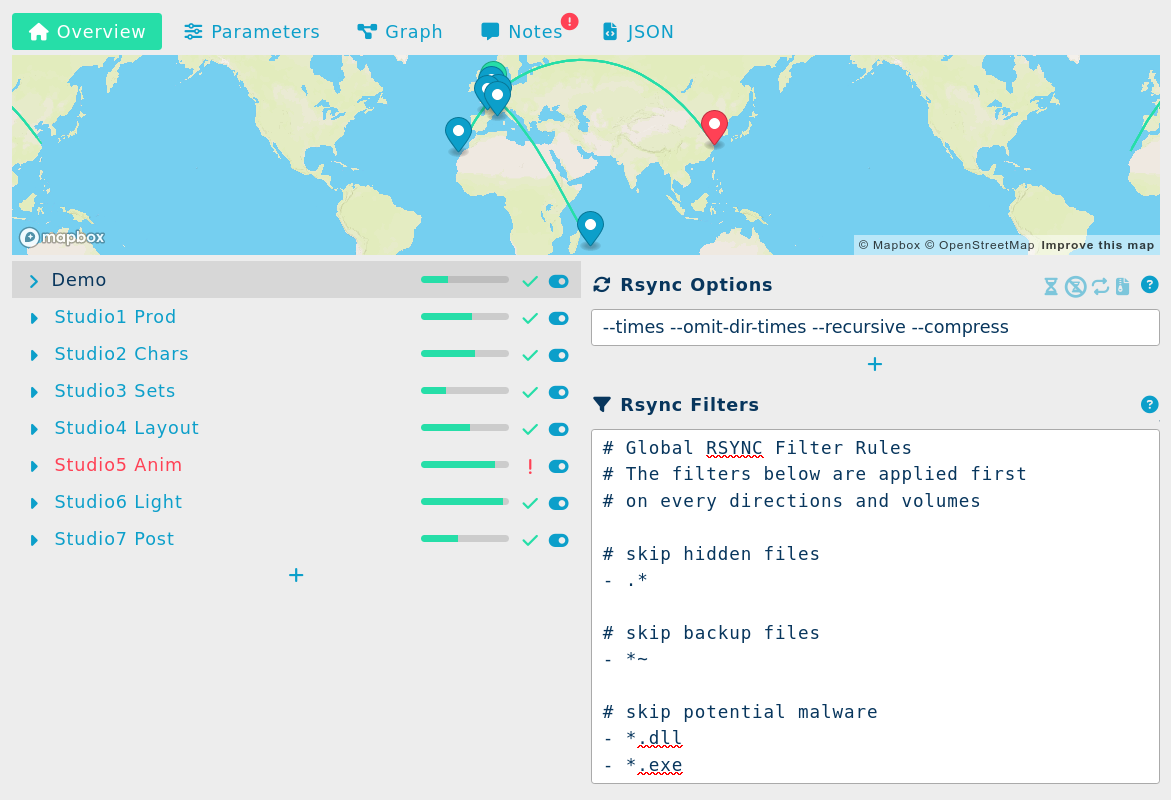
¶ Geographic Map
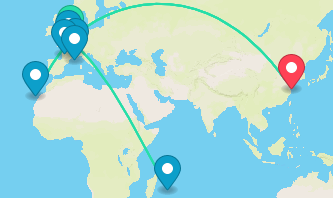
The map shows the hub, the connected volumes and their links. They are positioned using a IP address to geolocalization service. The green marker is the hub, blue markers are volumes, links are green. Error volumes are red, archived volumes are deep blue.
¶ Link Explorer
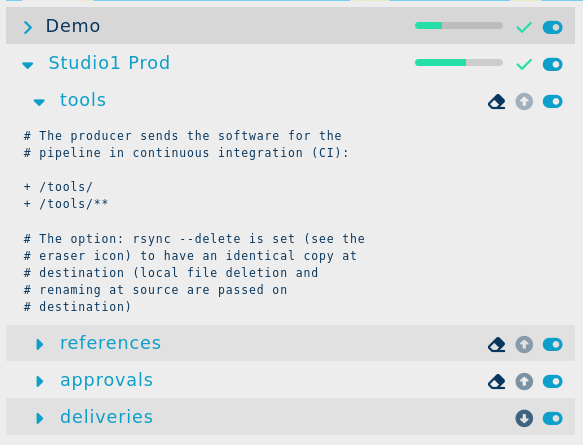
This is an interactive user interface that lets you explore the volumes and the links beneath them. The transmission activity is shown as a blinking icons and multiple links can be expanded to read several filters at a glance.
¶ Rsync Options and Filters
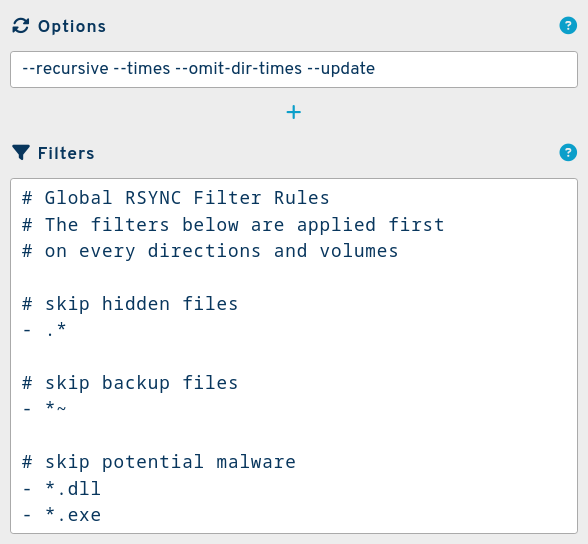
Control rsync options and filters to control various aspects of the file transfers.
These options and filters specified in the hub scope are applied on every rsync command for every volumes and links.
¶ Rsync Options
The hub's rsync options are global used on every rsync transmissions of this project. Read more on the Rsync Options page.
Example:
--times --update --omit-dir-times --recursive --compress
¶ Rsync Filters
The hub's rsync filters are also global and used on each rsync transfer. Visit the Rsync-Filters section for more details.
Here are basic filters that could be applied on a typical project:
# Global RSYNC Filter Rules # The filters below are applied first # on every directions and volumes # skip hidden files - .* # skip backup files - *~ # skip potential malware - *.dll - *.exe
This section have dedicated documentation pages: Rsync-Options and Rsync-Filters.
¶ Server Parameters

¶ Name (system)
A short hub or project's code name used to identify the project among the other projects. The format accepts a string from 3 to 16 characters long, containing lowercase characters and numbers only (regexp =
^[a-z0-9_]{3,16}$).
Example:
demo
¶ Long Name
A longer name, often the real long name with no size limit, used for the titles in documents.
Example:
Movie Production
¶ Short Name
A shorter name, used when the display needs a more consise form.
Example:
Demo
¶ Identifier
An automatically generated string to identify the hub of the form:
hub_#where#is a Universally Unique Lexicographically Sortable Identifier.
Example:
hub_01FX33ZYB78E9F5FTZMKC96A4P
¶ SSH Public Key
The public part of the key used to make the SSH connections to the connected volumes. This key is dedicated to the hub and to the project.
Example:
ssh-rsa AAAAB3NzaC1yc2EAAAADAQABAXACAQBYinfRa2J3Yst6TzAwB3mZ7a/yD4VplB/g4QWAJ8C/CkPEtCOArlFj9kAD1rbsRwq1qPb5HqFf6bMM/OQeYxNMf2HGjwBnFxQujVlb10hkrncKUL9wvKhtwjsLd5lGLTqH7A7ioUHjepLFRd6ntitvDAPI9JlCZoELyCZNEGYAgtBflazTXSlgYGZO23xzfFDZt22I9F1FmN7iDG2NxYHrmHa2B0D1VgqLtHbgQEzsh6PtQNAoTCMI25lt9Sy2inSMqS18IfJIe1OaBGo7tCPwFFzk7EwqHaa7ECHGmh6tHLO4XJ/Sgc7VCJiW9OV1nMlc1HRA8KeVDcCqIWZXagBy3DzIj0+7Ul/rxuY9KHh4XynWRRW8gtUVDlDbnbUOnbCl51D7I4HfQJWEJrZP6ModX/baQRkTi9XufsogWaRNTPKDvFFT3kP316DMdrwuy/guNlpnWEQq/UG13+z8JoJPe60wiUn6qMuk5L4Ftq7pqDaVsMTKlZnUzvRkEBA1sUKlBJSIX4lX5B6Ol0AxOEOlP9wME2+Vaf3qu8XMMmymTQlTSIksc3Ltc5PTsHUBkK6WWE5+T3Z+ZEE9MyBYhqsXLyaxuGCybuBIk9VUislYPk+1y43o2qRIBSop4TA1kEQ89xeAwS8afuSMJ5a7Af3jX4IaGE1YAooPRolgliQT2w== demohub@syncplanet
¶ Notifications
Events, such as volume disconnection/reconnection can be sent to notify some users (usually administrators) to a list of emails and/or to Discord channel using a webhook.
¶ Server Graph
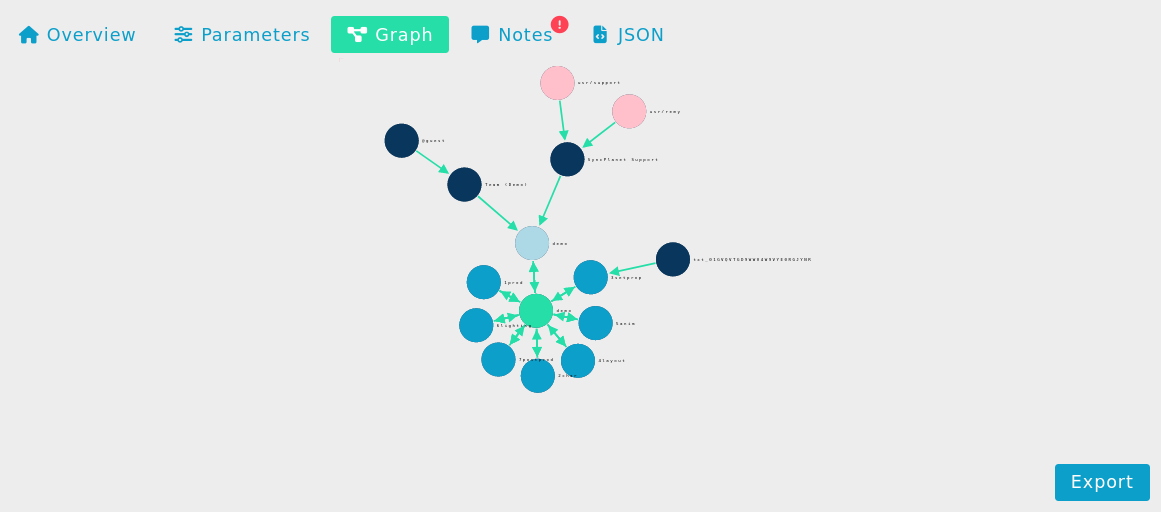
A view of the current's hub connections.
¶ Server Programming Interface
The hubs are described as JSON objects that you can modify using the API.
{
"_id": "hub_01FX33ZYB78E9F5FTZMKC96A4P",
"author": "support",
"bytesRemaining": 39450477204,
"bytesTotal": 57174604644,
"bytesUsed": 17724127439,
"comment": "# Movie Production Demo\n\nThis example is showing the data flows for a fictional 3D animated\nmovie production.",
"enable": true,
"error": 0,
"filters": "# Global RSYNC Filter Rules\n# The filters below are applied first\n# on every directions and volumes\n\n# skip hidden files\n- .*\n\n# skip backup files\n- *~\n\n# skip potential malware\n- *.dll\n- *.exe",
"geoloc": [3.17456,50.69421],
"hostname": "",
"image": "syncplanet/run:1.0.32",
"longName": "Movie Production",
"name": "demo",
"path": "/projects/demo/",
"rsaPublicKey": "ssh-rsa AAAAB3NzaC1yc2EAAAADAQABAXACAQBYinfRa2J3Yst6TzAwB3mZ7a/yD4VplB/g4QWAJ8C/CkPEtCOArlFj9kAD1rbsRwq1qPb5HqFf6bMM/OQeYxNMf2HGjwBnFxQujVlb10hkrncKUL9wvKhtwjsLd5lGLTqH7A7ioUHjepLFRd6ntitvDAPI9JlCZoELyCZNEGYAgtBflazTXSlgYGZO23xzfFDZt22I9F1FmN7iDG2NxYHrmHa2B0D1VgqLtHbgQEzsh6PtQNAoTCMI25lt9Sy2inSMqS18IfJIe1OaBGo7tCPwFFzk7EwqHaa7ECHGmh6tHLO4XJ/Sgc7VCJiW9OV1nMlc1HRA8KeVDcCqIWZXagBy3DzIj0+7Ul/rxuY9KHh4XynWRRW8gtUVDlDbnbUOnbCl51D7I4HfQJWEJrZP6ModX/baQRkTi9XufsogWaRNTPKDvFFT3kP316DMdrwuy/guNlpnWEQq/UG13+z8JoJPe60wiUn6qMuk5L4Ftq7pqDaVsMTKlZnUzvRkEBA1sUKlBJSIX4lX5B6Ol0AxOEOlP9wME2+Vaf3qu8XMMmymTQlTSIksc3Ltc5PTsHUBkK6WWE5+T3Z+ZEE9MyBYhqsXLyaxuGCybuBIk9VUislYPk+1y43o2qRIBSop4TA1kEQ89xeAwS8afuSMJ5a7Af3jX4IaGE1YAooPRolgliQT2w== demohub@syncplanet",
"rsync_args": "--times --update --omit-dir-times --recursive --compress",
"shortName": "Demo",
"time": 1639134611215,
"webhookURL": ""
}
You can read Environment-Setup and API for details about how to setup a client for Python, Javascript and Shell scripting.
¶ Next
You can try the hub demo interface or continue reading the documentation about the volumes and the links.